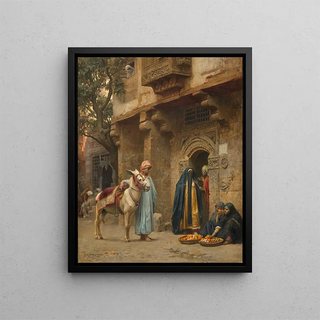Art print of a Cairo street - Frederick Arthur Bridgman


View from behind

Frame (optional)
In the vast panorama of Orientalist art, the artwork "Une rue du Caire" by Frederick Arthur Bridgman stands as a true ode to the beauty and exoticism of Egypt. This painting, which captures the vibrant essence of a lively street in Cairo, transports the viewer on a sensory journey into a rich and fascinating culture. Through shimmering colors and meticulous details, Bridgman succeeds in evoking an atmosphere that is both intimate and grandiose, thus revealing the magic of a city where history and modernity meet. The art print of this iconic piece allows for an appreciation of the depth and complexity of this scene, while offering a window into a world that is both distant and accessible.
Style and uniqueness of the artwork
One of the most striking features of "Une rue du Caire" lies in Bridgman's pictorial style, which combines realism and impressionism. The play of light and shadow, as well as the way colors blend on the canvas, creates an almost tangible atmosphere. The characters populating the scene, whether merchants, passersby, or children playing, are rendered with such liveliness that they seem to emerge from the painting to interact with the viewer. The composition is carefully orchestrated, with each element having its place within a harmonious whole. Architectural details, textures of clothing, and nuances of faces testify to meticulous attention, making this work not only a visual testimony but also an exploration of daily life in a vibrant Cairo full of colors and sounds.
The artist and his influence
Frederick Arthur Bridgman, 19th-century American painter, is renowned for his depictions of Oriental scenes, influenced by his travels in North Africa and the Middle East. His fascination with these cultures led him to capture authentic moments of life, while incorporating a romantic dimension into his works. Bridgman is part of an artistic movement that sought to explore exoticism, offering viewers an idealized yet profoundly human vision of these regions. His influence extends beyond his era, inspiring

Matte finish

View from behind

Frame (optional)
In the vast panorama of Orientalist art, the artwork "Une rue du Caire" by Frederick Arthur Bridgman stands as a true ode to the beauty and exoticism of Egypt. This painting, which captures the vibrant essence of a lively street in Cairo, transports the viewer on a sensory journey into a rich and fascinating culture. Through shimmering colors and meticulous details, Bridgman succeeds in evoking an atmosphere that is both intimate and grandiose, thus revealing the magic of a city where history and modernity meet. The art print of this iconic piece allows for an appreciation of the depth and complexity of this scene, while offering a window into a world that is both distant and accessible.
Style and uniqueness of the artwork
One of the most striking features of "Une rue du Caire" lies in Bridgman's pictorial style, which combines realism and impressionism. The play of light and shadow, as well as the way colors blend on the canvas, creates an almost tangible atmosphere. The characters populating the scene, whether merchants, passersby, or children playing, are rendered with such liveliness that they seem to emerge from the painting to interact with the viewer. The composition is carefully orchestrated, with each element having its place within a harmonious whole. Architectural details, textures of clothing, and nuances of faces testify to meticulous attention, making this work not only a visual testimony but also an exploration of daily life in a vibrant Cairo full of colors and sounds.
The artist and his influence
Frederick Arthur Bridgman, 19th-century American painter, is renowned for his depictions of Oriental scenes, influenced by his travels in North Africa and the Middle East. His fascination with these cultures led him to capture authentic moments of life, while incorporating a romantic dimension into his works. Bridgman is part of an artistic movement that sought to explore exoticism, offering viewers an idealized yet profoundly human vision of these regions. His influence extends beyond his era, inspiring
12,34 €






